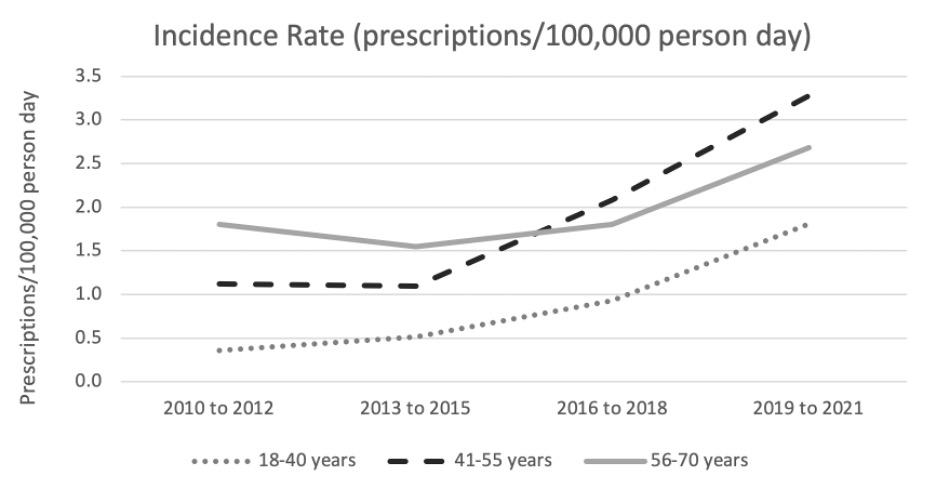Back
Poster, Podium & Video Sessions
Moderated Poster
MP35: Sexual Function/Dysfunction: Medical, Hormonal & Non-surgical Therapy I
MP35-18: Characteristics of Systemic Testosterone Therapy for Female Hypoactive Sexual Desire Disorder - A Claims Database Analysis
Saturday, May 14, 2022
4:30 PM – 5:45 PM
Location: Room 222
Pranjal Agrawal*, Kathryn Dumas, Taylor P Kohn, Jaden R Kohn, Marisa Clifton, Baltimore, MD
.jpg)
Pranjal Agrawal, BA
Johns Hopkins School of Medicine
Poster Presenter(s)
Introduction: Hypoactive sexual desire disorder (HSDD) is estimated to impact approximately 10% of women but is commonly undiagnosed. Systemic testosterone therapy (alone or with estrogen) improves libido in women with HSDD; however, concern for adverse effects may limit broad utilization. Our objective is to describe trends in systemic testosterone for HSDD using a large US claims database.
Methods: The TriNetX Diamond Network database was queried: a US health research network of 190 million patients, encompassing healthcare encounters and prescriptions. We identified female patients with HSDD (ICD-10 F52.0) without age limitation from 2010 to September 2021. Testosterone prescription trends (total prescriptions, number per patient, incidence over time [prescriptions/person-day] assessed in 2010-2012, 2013-2015, 2016-2018, and 2019-2021), route of administration, and coadministration with estrogen were extracted. Significance over time was assessed using Chi Square for trend.
Results: 37,491 women diagnosed with HSDD were identified with mean age 46.5±12.4 years. Only 3.9% of women with HSDD (n=1444) were prescribed systemic testosterone (mean age 50.6±10.0 years). Over time, a statistically significant increase in testosterone prescriptions for HSDD occurred, specifically for women age 18-40 years and 41-55 years, as seen in Figure 1 (p < 0.05). Most prescriptions were for injectable testosterone (56.8%), while 29.3% were for topical testosterone and 13.9% with route unknown. 556 women received only 1 prescription for systemic testosterone, 327 received 2-3 prescriptions, 262 received 4-9 prescriptions, and 299 received 10+ prescriptions. Systemic estrogen was co-prescribed for 543 women and vaginal estrogen was co-prescribed for 259 women; 642 women received no estrogen prescription.
Conclusions: Systemic testosterone therapy for HSDD remains rare but its use has increased over time; duration, route, and co-administration with estrogen remain highly variable. Long-term compliance with systemic testosterone therapy remains relatively low.
Source of Funding: None

Methods: The TriNetX Diamond Network database was queried: a US health research network of 190 million patients, encompassing healthcare encounters and prescriptions. We identified female patients with HSDD (ICD-10 F52.0) without age limitation from 2010 to September 2021. Testosterone prescription trends (total prescriptions, number per patient, incidence over time [prescriptions/person-day] assessed in 2010-2012, 2013-2015, 2016-2018, and 2019-2021), route of administration, and coadministration with estrogen were extracted. Significance over time was assessed using Chi Square for trend.
Results: 37,491 women diagnosed with HSDD were identified with mean age 46.5±12.4 years. Only 3.9% of women with HSDD (n=1444) were prescribed systemic testosterone (mean age 50.6±10.0 years). Over time, a statistically significant increase in testosterone prescriptions for HSDD occurred, specifically for women age 18-40 years and 41-55 years, as seen in Figure 1 (p < 0.05). Most prescriptions were for injectable testosterone (56.8%), while 29.3% were for topical testosterone and 13.9% with route unknown. 556 women received only 1 prescription for systemic testosterone, 327 received 2-3 prescriptions, 262 received 4-9 prescriptions, and 299 received 10+ prescriptions. Systemic estrogen was co-prescribed for 543 women and vaginal estrogen was co-prescribed for 259 women; 642 women received no estrogen prescription.
Conclusions: Systemic testosterone therapy for HSDD remains rare but its use has increased over time; duration, route, and co-administration with estrogen remain highly variable. Long-term compliance with systemic testosterone therapy remains relatively low.
Source of Funding: None


.jpg)
.jpg)